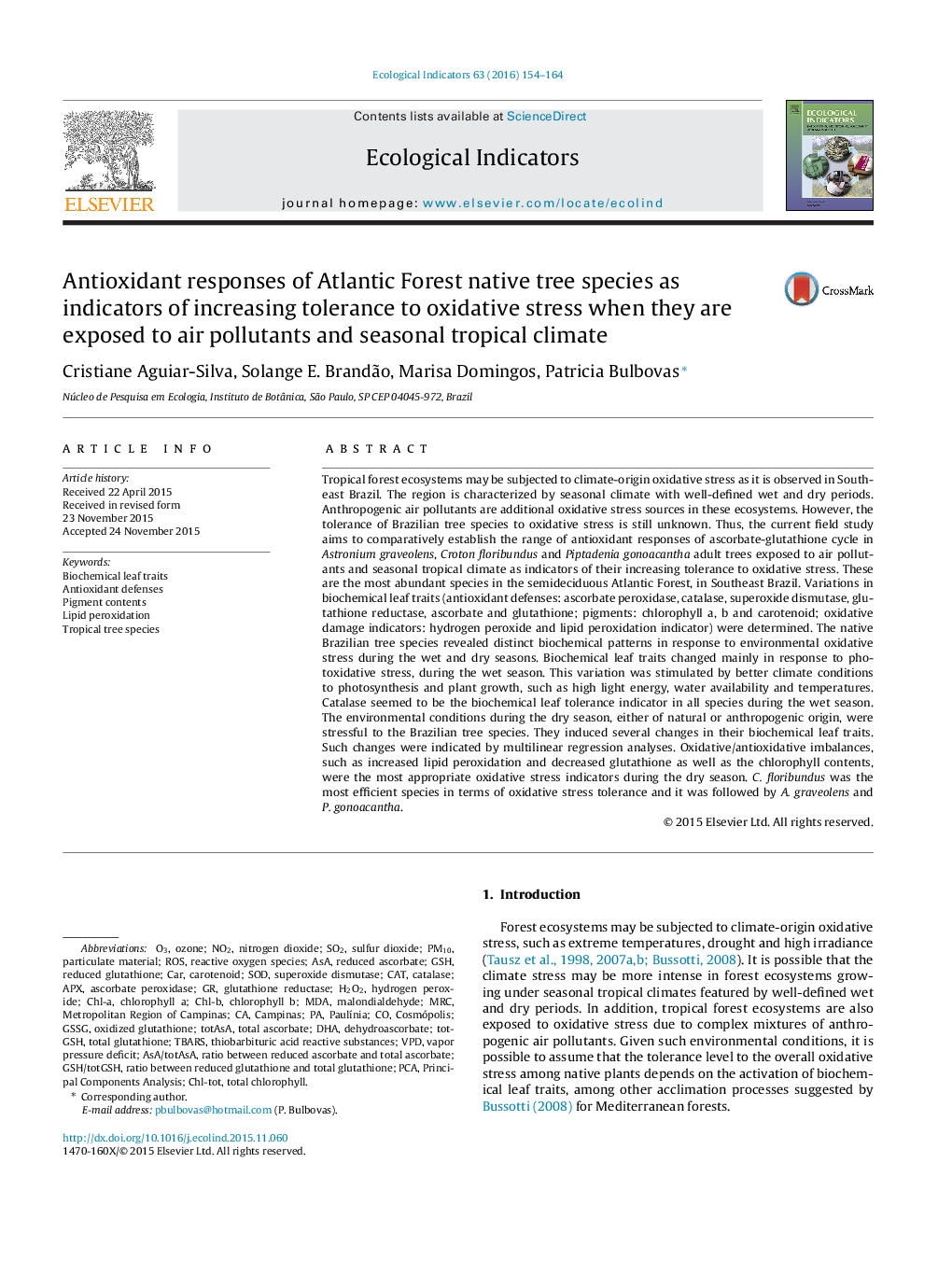| کد مقاله | کد نشریه | سال انتشار | مقاله انگلیسی | نسخه تمام متن |
|---|---|---|---|---|
| 6293838 | 1617139 | 2016 | 11 صفحه PDF | دانلود رایگان |
عنوان انگلیسی مقاله ISI
Antioxidant responses of Atlantic Forest native tree species as indicators of increasing tolerance to oxidative stress when they are exposed to air pollutants and seasonal tropical climate
ترجمه فارسی عنوان
پاسخ های آنتی اکسیدانی درختان بومی محلی جنگل های اقیانوس اطلس به عنوان شاخص های افزایش تحمل به استرس اکسیداتیو در معرض آلودگی هوا و هوای فصلی گرمسیری
دانلود مقاله + سفارش ترجمه
دانلود مقاله ISI انگلیسی
رایگان برای ایرانیان
کلمات کلیدی
APXtotal ascorbateMDAdehydroascorbateMRCChl-BChl-ATBARSGSSGGSHVPDCATASAPM10PCA - PCAROS - ROSHydrogen peroxide - آب اکسیژنهreduced ascorbate - آسکوربات کاهش یافته استOzone - اُزون Principal components analysis - تجزیه و تحلیل اجزای اصلیAntioxidant defenses - دفاع از آنتیاکسیدانDHA - دوکوساهگزائنوئیک اسیدSO2 - دی اکسید گوگردSulfur dioxide - دی اکسید گوگردSOD - سدSuperoxide dismutase - سوکسوکس دیسموتازCAR - ماشینmalondialdehyde - مالون دی آلدهیدParticulate material - مواد جامدthiobarbituric acid reactive substances - مواد واکنش پذیر اسید تیوباربیتوریکNO2 - نیتروژن دیاکسیدNitrogen dioxide - نیتروژن دیاکسیدH2O2 - هیدروژن پراکسیدascorbate peroxidase - پراکسیداز آسکورباتیLipid peroxidation - پراکسیداسیون لیپیدCatalase - کاتالازCarotenoid - کاروتنوئیدreduced glutathione - کاهش گلوتاتیونvapor pressure deficit - کسری فشار بخارChlorophyll a - کلروفیل achlorophyll b - کلروفیل بtotal chlorophyll - کلروفیل کلoxidized glutathione - گلوتاتیون اکسید شدهglutathione reductase - گلوتاتیون ردوکتازtotal glutathione - گلوتاتیون کلTropical tree species - گونه های درختان گرمسیریReactive oxygen species - گونههای فعال اکسیژن
موضوعات مرتبط
علوم زیستی و بیوفناوری
علوم کشاورزی و بیولوژیک
بوم شناسی، تکامل، رفتار و سامانه شناسی
چکیده انگلیسی
Tropical forest ecosystems may be subjected to climate-origin oxidative stress as it is observed in Southeast Brazil. The region is characterized by seasonal climate with well-defined wet and dry periods. Anthropogenic air pollutants are additional oxidative stress sources in these ecosystems. However, the tolerance of Brazilian tree species to oxidative stress is still unknown. Thus, the current field study aims to comparatively establish the range of antioxidant responses of ascorbate-glutathione cycle in Astronium graveolens, Croton floribundus and Piptadenia gonoacantha adult trees exposed to air pollutants and seasonal tropical climate as indicators of their increasing tolerance to oxidative stress. These are the most abundant species in the semideciduous Atlantic Forest, in Southeast Brazil. Variations in biochemical leaf traits (antioxidant defenses: ascorbate peroxidase, catalase, superoxide dismutase, glutathione reductase, ascorbate and glutathione; pigments: chlorophyll a, b and carotenoid; oxidative damage indicators: hydrogen peroxide and lipid peroxidation indicator) were determined. The native Brazilian tree species revealed distinct biochemical patterns in response to environmental oxidative stress during the wet and dry seasons. Biochemical leaf traits changed mainly in response to photoxidative stress, during the wet season. This variation was stimulated by better climate conditions to photosynthesis and plant growth, such as high light energy, water availability and temperatures. Catalase seemed to be the biochemical leaf tolerance indicator in all species during the wet season. The environmental conditions during the dry season, either of natural or anthropogenic origin, were stressful to the Brazilian tree species. They induced several changes in their biochemical leaf traits. Such changes were indicated by multilinear regression analyses. Oxidative/antioxidative imbalances, such as increased lipid peroxidation and decreased glutathione as well as the chlorophyll contents, were the most appropriate oxidative stress indicators during the dry season. C. floribundus was the most efficient species in terms of oxidative stress tolerance and it was followed by A. graveolens and P. gonoacantha.
ناشر
Database: Elsevier - ScienceDirect (ساینس دایرکت)
Journal: Ecological Indicators - Volume 63, April 2016, Pages 154-164
Journal: Ecological Indicators - Volume 63, April 2016, Pages 154-164
نویسندگان
Cristiane Aguiar-Silva, Solange E. Brandão, Marisa Domingos, Patricia Bulbovas,
